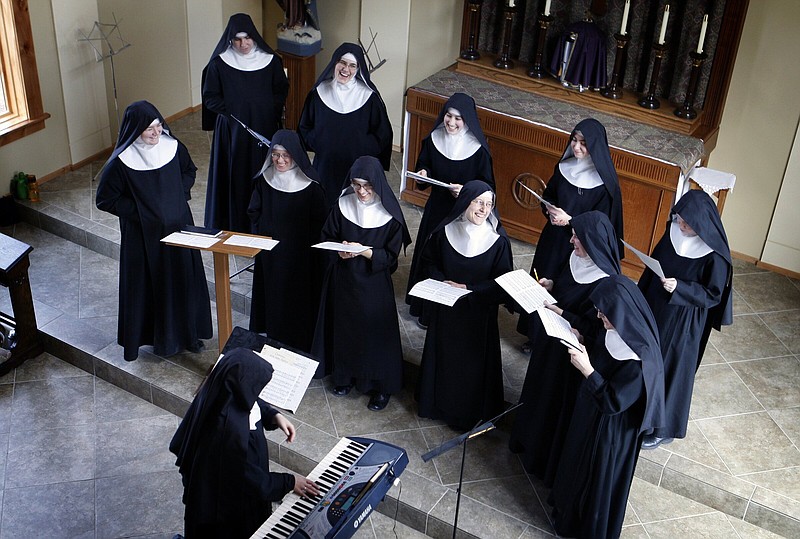A Benedictine monastery in the small town of Gower, Mo., is being inundated with calls and visitors since word has spread that the recently exhumed remains of its founder who died four years ago are remarkably preserved.
A story published Monday by the Catholic News Agency said that hundreds of people have traveled to the town about 40 miles north of Kansas City after hearing the news about Sister Wilhelmina Lancaster, the Black woman who founded the Benedictine Sisters of Mary, Queen of Apostles in 1995.
The Benedictine sisters are well known as recording artists who produce chart-topping Gregorian chant and Catholic hymn albums.
Sister Wilhelmina died on May 29, 2019, at age 95, and was buried in a wooden coffin. According to the Catholic News Agency, the abbess and sisters recently decided to move her body to inside their monastery chapel, a custom for founders.
But instead of finding bones in the coffin, the sisters discovered what appeared to be an intact body. The body had not been embalmed, the article said, and the coffin had a crack that had allowed moisture and dirt to get ins5de.
The abbess, Mother Cecilia, said they believe Sister Wilhelmina is the first Black woman to be found "incorrupt" -- or not decomposed after death.
"The body was covered in a layer of mold that had grown due to the high levels of condensation within the cracked coffin," the Catholic News Agency reported. "Despite the dampness, little of her body and nothing of her habit disintegrated during the four years."
The Catholic Church has more than 100 "incorruptible saints" who have been beatified or canonized, whose bodies have been entirely or partially immune to the natural decaying process years after their death, the Catholic News Agency report said. Catholic tradition holds that these saints provide witness to the truth of the resurrection of the body. The absence of decomposition also is considered a sign of holiness.
A nun who responded to a call from The Star on Monday evening said the monastery was not planning on doing any further interviews at this time.
"We thought, 'Well, we'll do one big story and then we'll just kind of limit it,'" she said. "We just don't have the capacity to receive all kinds of people. We're actually a little overwhelmed.
"This is kind of the first chapter in a bigger story -- or actually, the continuation of an amazing story. There's more to come on this, but for now we're just trying to take it a little slower."
The Diocese of Kansas City-St. Joseph posted a statement from Bishop James V. Johnston on its website Monday afternoon.
"The condition of the remains of Sister Wilhelmina Lancaster has understandably generated widespread interest and raised important questions," Johnston said. "At the same time, it is important to protect the integrity of the mortal remains of Sister Wilhelmina to allow for a thorough investigation.
"I invite all the Faithful to continue praying during this time of investigation for God's will in the lives of the Benedictines of Mary, Queen of Apostles; for all women religious; and all the baptized in our common vocation to holiness, with hope and trust in the Lord."
The church has not yet determined whether Sister Wilhelmina's case is miraculous or ruled it an "incorruptible," the Catholic News Agency reported, and a cause for her canonization has not been sanctioned. But the sisters in her religious community and those traveling from near and far to see the body describe it as something extraordinary.
Among those visiting was Rick Enna, of Kansas City.
"It was miraculous to see her body in perfect condition after her body was in a grave for close to four years," Enna, 61, told the Catholic News Agency.
The Benedictine nuns have put together a "fact sheet" to answer questions about the discovery. It said the body was exhumed on April 28.
"Not only was her body in a remarkable preserved condition, her crown and bouquet of flowers were dried in place; the profession candle with the ribbon, her crucifix, and rosary were all intact," it said.
"Even more remarkable was the complete preservation of her holy habit, made from natural fibers, for which she fought so vigorously throughout her religious life. The synthetic veil was perfectly intact, while the lining of the coffin, made of similar material, was completely deteriorated and gone."
The nuns created a wax mask for Sister Wilhelmina's face and also coated her hands with wax, the story said. Her body will be displayed in the chapel until Monday when there will be a rosary procession. After that, her body will be encased in glass in the chapel.
